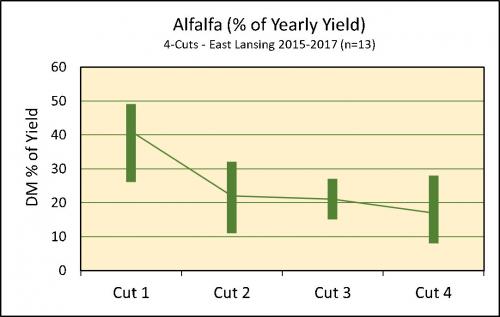The importance of first cutting alfalfa: Quality versus yield
First cutting alfalfa has historically been the highest-yielding cutting of the year

The old cliché, you never get over a good or bad start, is very true for the forage crop of alfalfa. Alfalfa is a legume that provides an excellent blend of fiber, protein and energy. When harvested at the appropriate time, alfalfa can provide excellent quality feed. Harvest too late and the consequences are poorer quality with higher yields. Harvest too early and the consequences are high quality with both reduced yields and reduced stand longevity. While every producer may want to harvest at the “sweet spot” between quality and yield, there is always a tradeoff between quality, yield and persistence based on time of cutting (Fig. 1).
Alfalfa is versatile enough to be used by most livestock operations in a variety of ways. Therefore, the quality will have a significant impact on how the animals respond, e.g., producing pounds of milk for dairy cows, pounds of gain for growing heifers or steers, or maintaining body condition for lactating beef cow. It makes sense to harvest with an end goal in mind for quality and yield, according to the type of livestock fed. Livestock performance and body condition can be excellent markers for whether the forage is meeting animal needs. Figure 2 illustrates how Relative Forage Quality (RFQ) relates to nutrient needs for different species and classes of livestock.
Producers have been using Relative Feed Value (RFV) widely for ranking alfalfa for sale, inventorying and allocating forage lots to animal groups according to their quality needs, as well as determining when to harvest. RFQ expands RFV and is an indexing tool that includes digestible fiber. The forage quality needs of a high producing milking cow is better met with alfalfa cut at the mid-bud stage, whereas the forage quality needs of an 18-24 month dairy heifer will be better met with more mature alfalfa harvested at the 1/10 bloom stage.

Figure 2. Different species of animals and forage quality needs. Adapted from Undersander, University of Wisconsin.
To illustrate the yield differences between cuttings, Michigan State University Extension’s Forage Variety Test Reports for 2015-2017 were summarized for East Lansing, Lake City and Chatham. East Lansing has historically used a four-cut system for alfalfa and Lake City and Chatham utilize a three-cut system. Each location will typically have unique growing environments for both temperature and rainfall.
When comparing percent of total yearly yield by cutting in the East Lansing yield summaries (n=13) a four-cut system was used (Fig 3). Average yields for first cuttings were 41 percent of the total year’s production and 2.2 tons dry matter per acre; 22 percent and 1.21 tons dry matter per acre for second cutting; 21 percent and 1.16 tons dry matter per acre for third cutting; and 17 percent and 0.91 tons dry matter per acre for fourth cutting.

Figure 3. Percent of yearly yield x cutting, East Lansing, MSU Alfalfa Yield Summaries 2015-2017.
When comparing percent of total yearly yield by cutting at the Lake City Research Station (Fig. 4), yield summaries (n=19) were based on a three-cut systems. Average yields were 49 percent and 1.66 tons dry matter per acre for first cutting; 34 percent and 1.18 tons dry matter per acre for second cutting; and 17 percent and 0.63 tons dry matter per acre for third cutting.

Figure 4. Percent of yearly yield x cutting, Lake City, MSU Alfalfa Yield Summaries 2015-2017.
When comparing percent of total yield by cutting at the Chatham Research Station in the Upper Peninsula (Fig. 5), yield summaries (n=9) were based on three-cut systems. Average yields were 59 percent and 1.85 tons dry matter per acre for first cutting; 29 percent and 0.90 tons dry matter per acre for second cutting; and 12 percent and 0.36 tons dry matter per acre for third cutting.

Figure 5. Percent of yearly yield x cutting, Chatham, MSU Alfalfa Yield Summaries 2015-2017.
The differences in percent of total yield among cuttings is more dramatic as the number of cuttings per year decreases from four to three.
In summary, if producers are harvesting their first cutting alfalfa for quality, remember the largest yield of the season is historically from first cutting. Therefore, keep a close eye on crop growth since temperature and moisture can affect plant maturity quickly (see Figs. 3, 4 and 5).
For more information, contact Phil Kaatz at 810-667-0341 or at kaatz@msu.edu, Kim Cassida at cassida@msu.edu or Jerry Lindquist at 231-832-6139 or lindquis@msu.edu.
Resources
- Comparison of Relative Forage Quality (RFQ) to Relative Feed Value (RFV), University of Wisconsin – Extension
- Forage Connection, Michigan State University



 Print
Print Email
Email